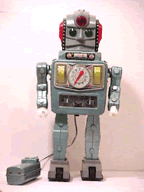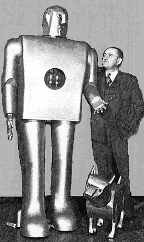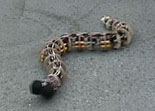- HOME
- VISIT
- ABOUT
- TOURS
- VISITOR FAQs
- LOCAL RESOURCES
- FAST FACTS
- MOAH HISTORY
- WILLIAMS HOUSE
- VICTORY GARDEN
- BOARD AND STAFF
- EXHIBITS
- CURRENT EXHIBIT
- PERMANENT EXHIBITS
- FUTURE EXHIBITS
- PAST EXHIBITS
- ARCHIVED EXHIBITS
- COLLECTION
- COLLECTION HISTORY
- DONATE TO THE COLLECTION
- SEARCH COLLECTION
- PROGRAMS & EVENTS
- CALENDAR
- ADULT PROGRAMS
- CHILDREN'S PROGRAMS
- ANNUAL EVENTS
- PAST EVENTS
- SPECIAL EVENTS
- GET INVOLVED
- MEMBERSHIP
- VOLUNTEER
- GIFT OPPORTUNITIES
- STAY CONNECTED
- EMAIL SIGNUP
- NEWSLETTERS
- PRESS
- Membership Response
Robots!
October 8, 1999 - January 23, 2000 The Museum of American Heritage was taken over by mechanical humanoids--with our colorful holiday exhibit entitled, Robots! Robots! traced the surprising richness of robotic evolution, with text combining history and popular imagination, fact and fiction. Featured objects included antique automata, a wide array of sometimes rare and colorful metal robot toys dating back to the early 1950's, and their practical descendants, the industrial, commercial, and medical robots.
Rocket Man
Exhibit Companion
-
Robots through History
- Stories of artificial men date back to prehistory. Pygmalian in ancient Greece and the Golem of Jewish tradition are just two such examples. With illustrations and antique examples, the exhibit traces robot development from marionettes to the dawn of the machine age, when the possibility of mechanical humans seemed an achievable goal. By the early 1800's machines that worked on the same principal as early music boxes mimicked the appearance and movements of humans and animals. These automata ranged from charming chirping birds in gilded cages to human forms that could draw, sing, write, and play musical instruments. At the same time, the harnessing of electricity inspired Mary Shelley's Frankenstein, which explored the dangers of scientifically engineered life.
- Origin of "Robot"
- A century later that danger was still being explored when the term "robot" was born, in a 1921 play by Czech playwright, Karel Capek. The play's name, R.U.R. stood for Rossum's Universal Robots, and the word robot itself was based on the Czech word for serf. As in Frankenstein, the experiment it chronicles ends in disaster, with the robot laborers rising up against their human creators. It was soon followed in 1926 by German Fritz Lang's Metropolis, a furiously bleak vision of a totalitarian future wherein a beautiful female robot leads a revolt of human laborers.
-
Robots Reach America
-

When the fascination with robots reached America, those ominous political and moral storm clouds evaporated in a sunny, optimistic scientific atmosphere. Popular imagination was given its model by the robots featured at the 1939-40 Worlds Fairs at New York and Treasure Island. In New York Westinghouse exhibited Elektro, a large metal man that could dance with humans, while his robot dog, Sparko, yapped gleefully. On Treasure Island Westinghouse showed off "Willie the Vocalite", who sat, stood, spoke, and even smoked. These, along with other displays by General Electric and IBM, seemed to point to a future filled with practical household robots.During the 1950's and 60's a renaissance of robot toys, science fiction books, and movies portrayed robots as omnipotent saviours-- The Day the Earth Stood Still --or as giant machines serving all mankind. The exhibit illustrates this period of imaginative artistic speculation with an impressive collection of vintage robot toys and books from that era. Elektro and Sparko, 1939 -
The Real Robots
- The American public learned of "electronic brains", essentially electronic oracles in temple-like buildings, in the 1940's. In the late 1950's and 1960's advances in the field of "artificial intelligence" produced computers that could play checkers and predict the results of elections, making a true thinking robot seem possible to an expectant public. But serious scientists had become intent on practical medical, industrial, and commercial applications. They soon discovered that the human form was not necessarily the most efficient one, especially for locomotion. Robots began to resemble other life forms, like spiders or snakes! Local experiments with different forms of robotic "arms" in the late 1960's and 1970's are chronicled in the exhibit by the "MIT" and "Stanford" arms, designed by local robotic expert, Victor Shienman, a medical robot from the Veteran's Hospital, and other miscellaneous commercial robot experiments. Such experimentation has led in an unexpected direction. Although robotic and computer technology has boomed in the last 20 years, much of it is hidden from public view. Few World's Fair visitors in 1939 could have imagined the sight of industrial robotic arms spraying paint, welding cars and assembling dishwashers in pitch black factories that operate all night. Nor would they have guessed that the huge electronic brains would become so small as to be carried around in pockets, all but forgotten by their users.
-
Recent Robot History
- Paradoxically, as the prospect of a practical humanoid robot faded, a counter trend developed in popular culture. The final portion of the exhibit features toys, books and posters from the late 1960's to the 1980's, when television and the movies reintroduced the robot, often as a friendly, helpful, humorous sidekick. The television series Lost in Space and movie Star Wars softened their robots' hard metallic edge by giving them human emotions and foibles. Although scientists may have temporarily abandoned attempts to build a mechanical human, the exhibit shows that popular culture may never abandon the search for Robots!

One of the snake robots
from the show!
Web Sites
Snakerobots.com Some slithery mechanisms

|
This page last updated April 18, 2001 |
 |
Membership
Join today! Membership dues help sustain MOAH. For more information and to download a Membership Form
LEARN MORE HERE
For questions and comments
Contact Us.
Mailing Address
PO Box 1731, Palo Alto, CA 94302
Join today! Membership dues help sustain MOAH. For more information and to download a Membership Form
LEARN MORE HERE
For questions and comments
Contact Us.
Mailing Address
PO Box 1731, Palo Alto, CA 94302
Visit
351 Homer Avenue
Palo Alto, California
p. 650.321.1004
e.
Contact Us for more info!
351 Homer Avenue
Palo Alto, California
p. 650.321.1004
e.

Hours of Operation:
Friday, Saturday and Sunday
from 11am to 4pm.


